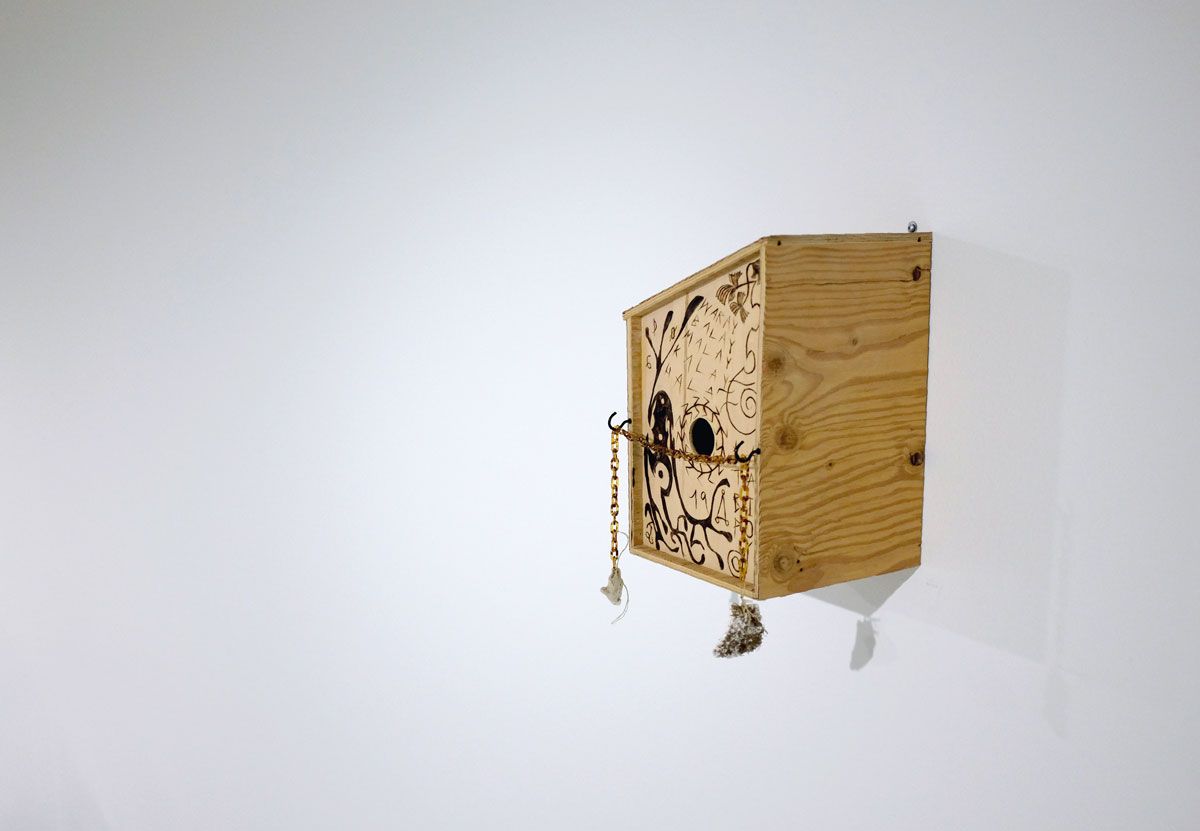When I first met Simon Grefiel — in queue for coffee — I was excited to talk to someone I didn’t know. For the most part I dread the light, informal conversation which emerges between strangers in lines — neither of us exactly sure when to cut the conversation off and say, “okay, well, I better order now!” Mostly, I dread the supply of adages and tropes I will relax into when I don’t know someone very well, which is something I can’t abide as someone who never really feels smart enough. For whatever reason, this didn’t happen with Simon. When we met, conversation was kind, and easy. I believe it’s because he is a person for which self-disclosure, chance, and a kind of unbarred approach to all things, is what drives his creativity. I say all this so you’ll understand that it was a moment of real coincidence when Discorder needed one last story, and I had just had a really good exchange with an artist I had only known for a few hours.
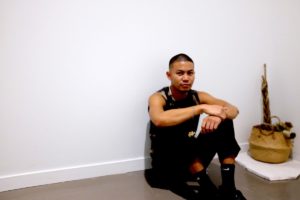
Fortuity aside, Simon’s work is incredibly good, and incredibly tender. Using both constructive and deconstructive collage methodologies to develop formal compositions like shrines, stained-glass ornamented pots and talismans, Simon’s visual language is spectral, but informed by phenomena in the material world. It is most compelling in it’s kaleidoscope vision of all that surrounds him — objects with living narratives, and offerings to spaces which pirouette around and through the white-walls. Everything is grist for the mill, even a chat in-line for coffee.
T: A really quick aesthetic description of your work could include terms like: Plant pots, shrines, installations, offerings and esoteric ornaments. There is something really magical about the sculptures you make. Do you think you can explain why your works look a certain way? Or is it an intuitive process that comes out of research?
Simon: I use those terms as ways to be literal about the function of the objects. Usually in art spaces objects are made and presented in a way to avoid a direct purpose. I use the shrine, talismans, and offerings because I have a clear intention as to what need they serve. Sometimes my intentions are clear, but the process in which the objects are made are very intuitive.
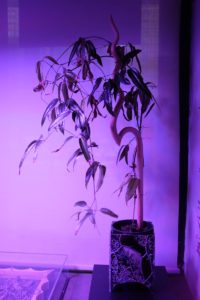
T: Tell me a bit about your piece, “Solar Noon Shrine” at the VAG’s Vancouver Special: Disorientations and Echo. You have to really look at it to catch what’s going on, as if it’s meant to be beautiful (rather than abstract) in order to offer a deeper plot. Are they mutually influential, these aesthetic and spiritual practices?
S: I think it’s visually beautiful because beautifying/ornamenting the space serves a function —preparing it to house objects that hold strong spiritual meaning. The walls are painted with clay. I take these things very seriously and I would do whatever it takes to honor a space where I think it’s conducive enough for a spirit to dwell.
T: What practices are involved in making sure it’s conducive for a spirit?
S: It’s important that “Solar Noon Shrine” has sculptural elements because a lot of the physical objects are charged. The plants, for example, have been cared for in previous spaces — at Libby Leshgold Gallery, my home, my studio, and the nursery from where they were originally grown. The dried leaves that adorn the railings are from years of collected trimmings from plants.
In the center of “Solar Noon Shrine” is the sifter. It was made in collaboration with my friend Tiziana La Melia, where we performed rituals that encouraged folks to stop by and make offerings. Some offerings were potent, and it was important for me to honour them. Also, in thinking through an animistic philosophy, it was important to consider the plants also as a vessel for a spirit — or rocks to be gifts from one.
T: Can you tell me more about what the mediums you work in offer? It seems like there is a kind of poeticism to all your material choices, which is why I find your work so alchemic. Is material as important to you as a practice, or do you prefer it as a means to an end?
S: Glass has its own breaking point when there is too much pressure. Lead has a melting point and how it behaves depends on how much heat has been applied. Plants grow the way they want, depending on the environment it is provided. In that sense, physical materials have their needs […] I find pleasure in finding the sweet spot between myself and the materials I work with. Whatever objects I presented to the public are the result of those relationships in the studio that haven’t yet broken.
I think a material on its own is not as poetic as if it were with another material. I find poetry is in the space created between materials and the viewer together. For example, what fills in the space between stained glass and a tropical plant? I find the more difficult it is for me to talk about its relationship, the more worthwhile it is for me to make that work. I think that makes an artwork a lot more potent. […] Different materials, which have their own needs, and completely different processes, plus what the architecture allows in the corner (sunlight) all are forces that pull in every direction and creating a wide space for relations to be conjured.
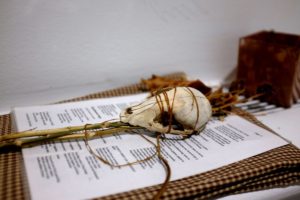
T: That’s really interesting, it’s almost a kind of meditation on the liminal space (space between what’s next) or honoring connectivity (the space conjoined.) What material combinations have been really exciting to you lately, or what is your process to them?
S: Currently, my process is collecting rocks, feathers, cigarette butts, calling my friends for hours of gossip, tangents, dating, watering and trimming my plants, exploring my masculinity, stopping to observe animals, spending time with my goddaughters, hours of absorbing and collecting digital media, drinking with my family and listening to oral histories, napping, recording internal dialogues, pilgrimages to special sites, updating my personal research blogs, trying to remember my spirit familiar’s name in my dreams, and material outbursts in the studio.
T: What other parts of your life bleed into your art practice? How do they inform what you do, how you do it, or what something looks like?
I find inspiration literally everywhere and every interest I have probably bleeds into my practice. I think maybe that’s why my work can seem intimate. My studio practice is this intuitive outburst of what is adjacent to me. The plants are a thing because I learned so much from my plant obsession in quarantine, so of course it ended up in my practice. Stained glass is prominent too, because of my time working for Julian Hou — I used mostly off cuts. The digital works were made at a time when I was broke with no studio and had intense insomnia so I would spend long nights on my laptop. I work with what I have, and I push processes to reach their full potential in terms of how they can articulate my obsessions.
T: The way I engage with art is about combining things that are totally random until they make sense together. I get a sense that your practice is informed by the opposite: your pieces are composed of very intentional decisions — these articulations of your obsessions, which clearly have a research element, and a deep knowledge of a history of representation. Do you worry about balancing these aspects, or if viewers (like myself) might miss something important?
A lot of my works are informed by a very wide range of research tangents, and what is put out to the world are moments when I am confident enough to anchor them intuitively. Most importantly, Waray-Waray and Cebuano language informs a lot of my philosophy of the spiritual/material world. Sometimes I’ve even made work dedicated to trees — I think about making work that is legible to non-humans. If an object is hung 40 feet above us, perhaps it is for someone else other than us.
T: What do you look at, read, or listen to that inspires your work?
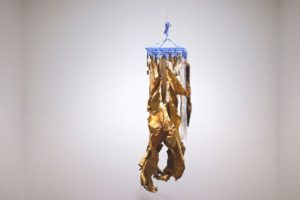
S: I like reading about prehistory and finding similarities that we still do today. It reminds me that humans around the world have always been making objects/images that evade usually notions of functionally, objects that evade a secular, capitalist lifestyle. It makes art-making seem like a super small blip in a time-frame of people making objects for healing/pleasure/community.
T: I love that way of approaching art. I think there is this really punishing culture of productivity and professionalism, and it lends to a lot of work feeling really… insincere. It’s really freeing to understand making, and viewing art, as a super small blip in time of this inexhaustible human trait. It means the work can come from this really kind place. That we can also approach objects in a really kind way. How do you honour that in your daily life? Or in your work specifically?
A lot of ‘talismans’ I make are given to my friends with them specifically in mind. One for heartbreak, safe travels, and as a conduit to receive my prayers through a grieving ceremony. “Talisman #3” was made originally for my home last year which I like to think protected me, my roommates, and my goddaughter during lockdown. “Garden Angel” is dedicated to a tree that was a source of comfort during quarantine. I think making objects in this way dovetails back to a process everyone in the world have been doing long before the word Art was a thing.
I’m still figuring myself out in this lifetime. The languages I grew up speaking in the islands of Leyte and Cebu are the foundation to my souls and are the constant in this life. I think that will stay with me until my physical death.


